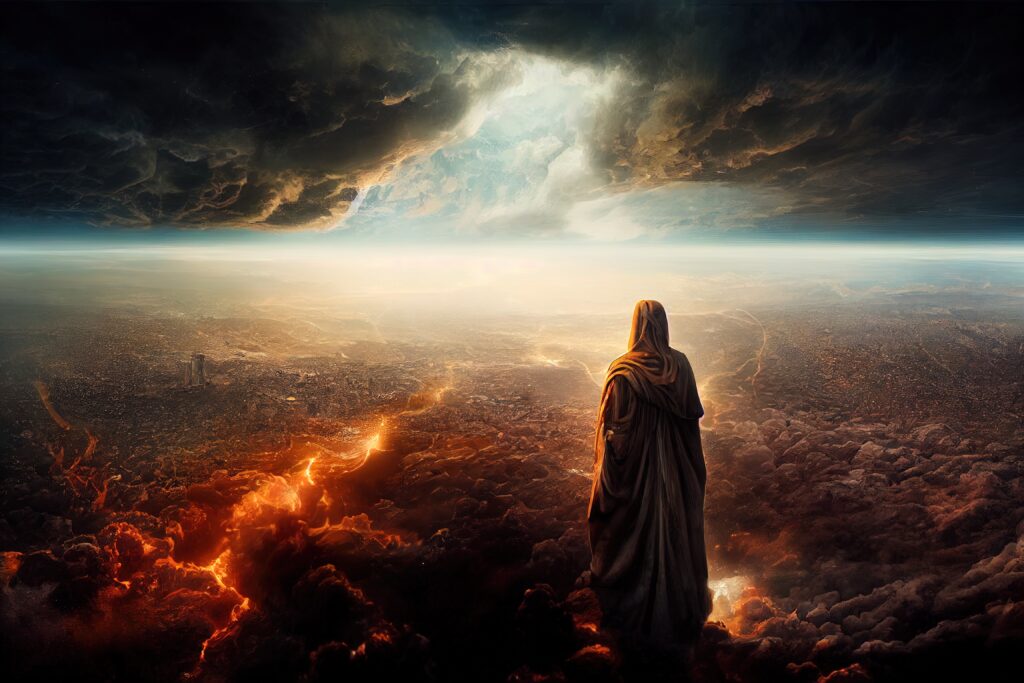
Things are About to Get Very Unpleasant.
“Then I looked and saw that the Temple in heaven, God’s Tabernacle, was thrown wide open. The seven angels who were holding the seven plagues came out of the Temple. They were clothed in spotless white linen with gold sashes across their chests. Then one of the four living beings handed each of the seven angels a gold bowl filled with the wrath of God, who lives forever and ever. The Temple was filled with smoke from God’s glory and power. No one could enter the Temple until the seven angels had completed pouring out the seven plagues” – Revelation 15:5-8.
In contrast to the smoke of the world’s torment (Rev 14:10-11), we have here the smoke of the glory of God. This is reminiscent of the scenes that accompanied the dedication of both the wilderness tabernacle (Ex. 40:34-35) and Solomon’s temple (1 Kgs 8:10-12). God filled these places with His glory to celebrate the time of their dedication. In Revelation 15 He does so in response to the worship of His dedicated people (Rev 15:3-4), who suffered at the hands of the wicked ones who will now taste His severe judgments.
After the Exile in Babylon, Zerubbabel raised up a more modest temple (Hag 1:12 – 2:9) to replace Solomon’s, which had been destroyed by Nebuchadnezzar (2 Chr 36:18-19). This building also was celebrated with a ceremony of dedication (Ezra 6:1318). A similar service was held nearly a hundred years later to celebrate the completion of the walls of Jerusalem under Nehemiah, which safely enclosed the holy precincts once more (Neh 12:27-47).
The Feast of Dedication as we know it (called Hanukkah today), however, did not originate in Old Testament times.
It celebrates the re-dedication of the temple in Jerusalem after its defilement by Antiochus Epiphanes (165 BC). Among other things, Antiochus sacrificed a pig on the temple altar, forbade keeping of the Sabbath, and compelled many Jews to eat pork. The Maccabees, a group of Jewish insurgents, liberated Jerusalem from the clutches of Antiochus iv, they cleansed and rededicated the temple. The celebration which followed became an annual feast of Judaism. Hanukkah means dedication.
In our text we have something along the lines of an “un-dedication.” The glory of God drives out the angels. But instead of returning in a short while to begin their temple duties, as would be the case for a dedication service, they move on to other, more painful duties.
God marks the unpleasant turns of life as well as the pleasant ones. For the next few chapters things will become very unpleasant indeed. It gets ugly before it gets beautiful!
The wrath of God is ready to be poured out on an unrepentant world that has spurned the free gift of His grace, crucified His Son, and persecuted His followers. Christ, who has interceded on man’s behalf, has left the temple. Probation has closed for humanity. The glory of God has filled the temple and the four angels who have been holding back the winds of strife (Rev 7:1) are turned loose. Now the seven angels, having the seven plagues, can complete their work. Some people stress over the fact that Jesus, the mediator, is no longer in the temple interceding, but revelation 14 had told us that God’s people have been sealed with the Holy Spirit.
Like Noah in the Ark, the doors were sealed but the rain was still 7 days away. When Christ ceases His intercession and leaves the temple, God’s people are sealed with the Holy Spirit, and the 7 last plagues begin.
Revelation 11:18 had summarized events on earth right before the battle of Armageddon: “The nations were angry”. This state of affairs on earth matches Jesus’ description of the last days (Luke 21:25) and is followed by God’s wrath, which are His judgments in the form of the seven last plagues upon the unrepentant (Rev 15:12). The phrase “the wrath of God” occurs 7 times between Revelation14:10 and 16:19.
Revelation 15 opened with the picture of seven angels with seven bowls filled with this divine wrath. But before this outpouring happens, we have a future glimpse of God’s faithful people (Revelation 15:1-4). They are described as victorious “over the beast, over his image and over his mark and over the number of his name” (Revelation 15:2,) as they stand on something resembling a sea of glass and sing the song of Moses and the Lamb – all images reminiscent of the Hebrews on the shores of the Red Sea, celebrating God’s victory over the Egyptians (Ex 15).
These victorious saints are the same ones referred to as the great multitude, in Revelation 7:9 and, symbolically, the 144,000 in Revelation 14:1-5. Having refused the mark of the beast, they are sealed – protected from the seven last plagues. Then, at the Second Advent, their mortal bodies are transformed and clothed with immortality, their corruption is transformed into in-corruption because they can sin no more (1Cor 15:51-54,) and they will join the resurrected saints when Jesus comes in power and glory (1Thess 4:17). Ahhh blissful moment!
Maranatha – “even so come Lord Jesus”.(Revelation 22:20)

Amen! What a day that will be when we see Jesus face to face.
Thanks Ross for reminding us that we have nothing to fear, we are sealed in Jesus.
By the Holy Spirit!